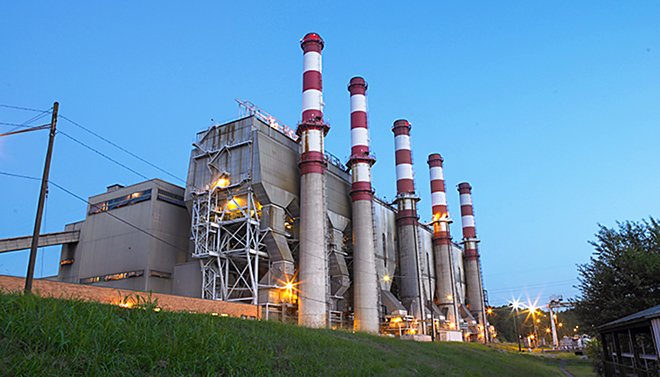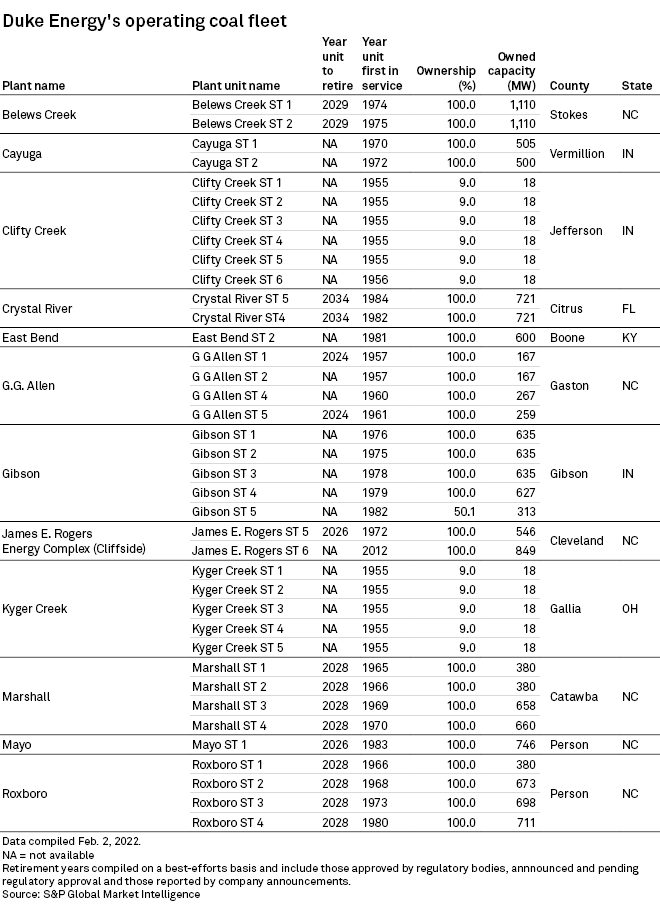
The 860-MW G.G. Allen plant in North Carolina is among the facilities Duke Energy expects to retire as part of its goal to exit coal generation by 2035. |
Duke Energy Corp. on Feb. 9 announced plans to cut coal to less than 5% of its total generation by 2030 and to fully exit coal by 2035, in what the company described as the "largest planned coal fleet retirement in the industry."
According to S&P Global Market Intelligence data, Duke Energy owns about 16 GW of coal-fired generating capacity, making up a little more than a quarter of its overall owned portfolio.
Duke Energy also announced plans to expand its 2050 net-zero goals to include Scope 2 and certain Scope 3 emissions.
In its electric business, the company's net-zero goal includes cutting greenhouse gas emissions from the power it buys for resale, from purchasing fossil fuels for generation and from electricity the company buys for its own use.
For Duke Energy's natural gas business, the company said it would add a new net-zero by 2050 goal that includes upstream methane and carbon emissions related to purchased gas and downstream carbon emissions from customer consumption.
Scope 1, 2 and 3 emissions are based on the Greenhouse Gas Protocol, which defines Scope 1 emissions as direct emissions from the company, Scope 2 as indirect emissions from power the company buys from others for use in its facilities and Scope 3 as indirect emissions from others in the company's value chain, Duke said in its news release.
The North Carolina-headquartered utility, which serves retail electric and natural gas customers in six states, announced it has so far reduced Scope 1 carbon emissions from electricity generation by 44% from 2005 levels, equivalent to removing about 13 million vehicles from the road.
Duke Energy is also on pace to achieve its goal of at least 50% emissions reductions by 2030 and net-zero by 2050 from electricity generation and net-zero methane emissions by 2030, according to the company.
Duke Energy said it has made progress toward those goals by so far retiring 56 coal units representing about 7.5 GW since 2010, filing integrated resource plans with preferred scenarios supporting a 2035 coal exit and partnering with Accenture PLC and Microsoft Corp. on a satellite leak detection platform to measure baseline methane emissions from natural gas distribution systems.
Duke Energy intends to take a "leadership role in tackling the greenhouse gas emissions associated with our business and value chain," and the company's policy changes and technological innovation are expected to play key roles in reaching those goals, Duke Energy Chief Sustainability Officer Katherine Neebe said in a statement Feb. 9. The company is scheduled to release its fourth-quarter 2021 earnings results Feb. 10.

North Carolina regulators in November 2021 approved a five-year action plan for subsidiaries Duke Energy Carolinas LLC and Duke Energy Progress LLC that includes the retirement of the 860-MW G.G. Allen coal plant in Gaston County. A month prior, North Carolina enacted legislation to speed retirements and reduce carbon emissions by 70% by 2030 from 2005 levels.
The Duke Energy utilities initially asked that state regulators in North Carolina and South Carolina hold joint proceedings to consider a carbon-reduction plan for both states that would comply with the North Carolina legislation. Duke later withdrew that request following opposition from public officials.
Duke may have a more difficult path toward coal retirements in South Carolina. Regulators there in December 2021 rejected the companies' preferred power plant construction plan in favor of an alternate plan, potentially delaying coal plant retirement timelines.
In the 2020 integrated resource plans for the two Carolinas utilities, the company proposed retiring all of its power plants in the Carolinas that rely exclusively on coal this decade, replacing them largely with renewables and natural gas. An S&P Global Market Intelligence analysis showed Duke Energy operated about 9,000 MW of coal-fired generation in the Carolinas in 2020.
Duke Energy Indiana LLC's 2021 integrated resource plan included additional renewables and continuing gas generation in a preferred portfolio that would retire the 1,005-MW Cayuga units 1 and 2 by 2027, the 313-MW unit 5 at the Gibson plant by 2025 and Gibson units 3 and 4, totaling 1,262 MW, by 2029. Gibson units 1 and 2, totaling 1,270 MW, would shutter by 2035 under the preferred portfolio. Duke Energy Indiana's plan would continue about 2,000 MW of coal capacity beyond 2030 and build an additional 1,000 MW of gas generation over the next decade.



